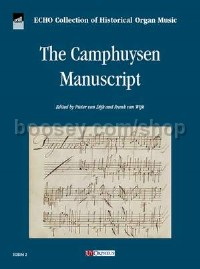The Camphuysen Manuscript Volume 2
The Camphuysen Manuscript Volume 2
* Estimated price converted from UK retail price
ECHO (European Cities of Historical Organs) was founded in 1997 upon a proposal made by Andrea Marcon, by the cities of Alkmaar (Netherlands), Innsbruck (Austria), Lisbon (Portugal), Roskilde (Denmark), Treviso (Italy), Toulouse (France) and Zaragoza (Spain). This union of cities both with historical organs and a festival or an international competition then decided to unite their efforts, share documentation on historical instruments, make common projects and exchanges, help students exchanges, and promote the construction of new instruments based on historical examples.
One of the latest projects of ECHO is ECHOM (ECHO Collection of Historical Organ Music). It concerns the conception and the realization of a series of organ music scores presented by the different cities, members of ECHO. The series of ten volumes (two per year between 2018 and 2022, general editor: Jean Ferrard) will involve unpublished or out of print complete manuscripts, and not excerpts. The musicological value of the collection depends on its detailed historical comments, complete critical reports and a demanding and responsible editorial policy, following the usual high standards of the organ publications of Ut Orpheus, Bologna.
The Organ Magazine
... The printing is extremely clear and carefully laid out so that there are no unmanageable page turns. A facsimile of each piece is included within the music text. Perhaps the overall contents are of greater interest to early music specialists wishing to learn more about domestic keyboard music written by Sweelinck’s successors, but the variations are valuable as teaching material and could be included in recitals. (https://www.theorganmag.com/bookrevs/Camphuysen.html)
The Consort Magazine (Summer 2019)
... The edition opens with the general conventions adopted for the series, a short bibliography and a detailed preface describing the manuscript's origin and content, notation and performance options including ornaments - the pieces contain many single- and double-stroke ornament signs - and the policy on accidentals. There is a critical report on each piece, its origin and any editorial amendments. The printing is clear and carefully laid out, with no unmanageable page turns; a facsimile of each piece is included. The book will chiefly interest early music specialists wishing to learn more about domestic keyboard music written by Sweelinck 's successors, but the variations will be valuable as teaching material and could be included in recitals. (John Collins)




